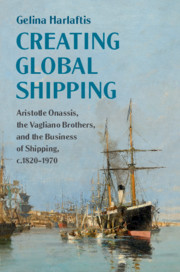Refine search
Actions for selected content:
26946 results in Economic history
Contents
-
- Book:
- A Great Deal of Ruin
- Published online:
- 05 August 2019
- Print publication:
- 22 August 2019, pp v-ix
-
- Chapter
- Export citation
11 - Monetary Policy Does Not Always Work
- from Part III - Lessons
-
- Book:
- A Great Deal of Ruin
- Published online:
- 05 August 2019
- Print publication:
- 22 August 2019, pp 224-236
-
- Chapter
- Export citation
Part I - Financial Crises
-
- Book:
- A Great Deal of Ruin
- Published online:
- 05 August 2019
- Print publication:
- 22 August 2019, pp 15-66
-
- Chapter
- Export citation
3 - The Great Depression, 1929–1939
- from Part II - Five Case Studies
-
- Book:
- A Great Deal of Ruin
- Published online:
- 05 August 2019
- Print publication:
- 22 August 2019, pp 69-91
-
- Chapter
- Export citation
Tables
-
- Book:
- A Great Deal of Ruin
- Published online:
- 05 August 2019
- Print publication:
- 22 August 2019, pp x-x
-
- Chapter
- Export citation

Creating Global Shipping
- Aristotle Onassis, the Vagliano Brothers, and the Business of Shipping, c.1820–1970
-
- Published online:
- 19 August 2019
- Print publication:
- 29 August 2019
A Spirit of Generosity: Philanthropy in the Scotch Whisky Industry
-
- Journal:
- Business History Review / Volume 93 / Issue 3 / Autumn 2019
- Published online by Cambridge University Press:
- 14 August 2019, pp. 529-552
- Print publication:
- Autumn 2019
-
- Article
- Export citation
Peer-to-peer lending in pre-industrial France
-
- Journal:
- Financial History Review / Volume 26 / Issue 3 / December 2019
- Published online by Cambridge University Press:
- 13 August 2019, pp. 359-388
-
- Article
-
- You have access
- Open access
- HTML
- Export citation
INEQUALITY AND WELL-BEING IN IBERIAN AND LATIN AMERICAN REGIONS SINCE 1820. NEW APPROACHES FROM ANTHROPOMETRIC HISTORY
-
- Journal:
- Revista de Historia Economica - Journal of Iberian and Latin American Economic History / Volume 37 / Issue 2 / September 2019
- Published online by Cambridge University Press:
- 07 August 2019, pp. 193-204
- Print publication:
- September 2019
-
- Article
- Export citation
RHE volume 37 issue 2 Cover and Back matter
-
- Journal:
- Revista de Historia Economica - Journal of Iberian and Latin American Economic History / Volume 37 / Issue 2 / September 2019
- Published online by Cambridge University Press:
- 07 August 2019, pp. b1-b2
- Print publication:
- September 2019
-
- Article
-
- You have access
- Export citation
RHE volume 37 issue 2 Cover and Front matter
-
- Journal:
- Revista de Historia Economica - Journal of Iberian and Latin American Economic History / Volume 37 / Issue 2 / September 2019
- Published online by Cambridge University Press:
- 07 August 2019, pp. f1-f4
- Print publication:
- September 2019
-
- Article
-
- You have access
- Export citation
Entrepreneurship, Strategy, and Business Philanthropy: Cotton Textiles in the British Industrial Revolution
-
- Journal:
- Business History Review / Volume 93 / Issue 3 / Autumn 2019
- Published online by Cambridge University Press:
- 06 August 2019, pp. 503-527
- Print publication:
- Autumn 2019
-
- Article
- Export citation

A Great Deal of Ruin
- Financial Crises since 1929
-
- Published online:
- 05 August 2019
- Print publication:
- 22 August 2019
THE CHANGING SIGNIFICANCE OF LATIN AMERICAN SILVER IN THE CHINESE ECONOMY, 16TH–19TH CENTURIES
-
- Journal:
- Revista de Historia Economica - Journal of Iberian and Latin American Economic History / Volume 38 / Issue 3 / December 2020
- Published online by Cambridge University Press:
- 23 July 2019, pp. 553-585
- Print publication:
- December 2020
-
- Article
-
- You have access
- Open access
- HTML
- Export citation
GLOBAL QUANTIFICATION AND INVENTORY DEMAND FOR SILVER IN CHINA
-
- Journal:
- Revista de Historia Economica - Journal of Iberian and Latin American Economic History / Volume 38 / Issue 3 / December 2020
- Published online by Cambridge University Press:
- 22 July 2019, pp. 421-447
- Print publication:
- December 2020
-
- Article
-
- You have access
- Open access
- HTML
- Export citation
FHR volume 26 issue 2 Cover and Front matter
-
- Journal:
- Financial History Review / Volume 26 / Issue 2 / August 2019
- Published online by Cambridge University Press:
- 16 July 2019, pp. f1-f3
-
- Article
-
- You have access
- Export citation
FHR volume 26 issue 2 Cover and Back matter
-
- Journal:
- Financial History Review / Volume 26 / Issue 2 / August 2019
- Published online by Cambridge University Press:
- 16 July 2019, pp. b1-b2
-
- Article
-
- You have access
- Export citation
Alternative finance: a historical perspective
-
- Journal:
- Financial History Review / Volume 26 / Issue 2 / August 2019
- Published online by Cambridge University Press:
- 16 July 2019, pp. 109-126
-
- Article
- Export citation
Stock market co-movement, domestic economic policy and the macroeconomic trilemma: the case of the UK (1922–2016)
-
- Journal:
- Financial History Review / Volume 26 / Issue 3 / December 2019
- Published online by Cambridge University Press:
- 16 July 2019, pp. 295-320
-
- Article
- Export citation
The trade-offs between macroeconomics, political economy and international relations
-
- Journal:
- Financial History Review / Volume 26 / Issue 3 / December 2019
- Published online by Cambridge University Press:
- 10 July 2019, pp. 247-266
-
- Article
- Export citation
